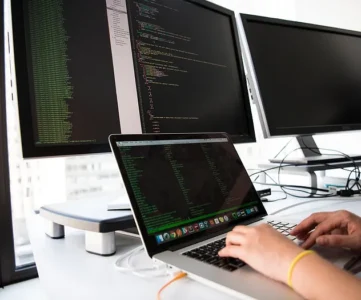Software development is often perceived as a purely technical field dominated by logic, structure, and efficiency. However, for many developers, it is much more than that. It’s a creative outlet that bridges technology and imagination, a medium where artistry and innovation come to life in the form of digital solutions. For those with a passion for creativity, software development becomes a perfect space to express their artistic side, much like painting on a blank canvas or composing a new piece of music.
I have found that software development appeals to my artistic, creative, and imaginative side, which is why I constantly strive to grow and evolve as a developer. The dynamic nature of this field offers endless opportunities for exploration, and as Lode Palle continue on my journey, I aim to better myself by pushing boundaries, embracing new technologies, and solving complex problems in ways that reflect my unique creative approach.
In this blog, I will explore how software development intertwines with creativity and artistry, how it fuels personal growth, and the ways I constantly seek to improve as a developer.
The Artistic Nature of Software Development
When we think of art, we often picture traditional mediums such as painting, sculpting, or writing. However, software development, too, can be seen as a form of art. The process of coding, designing, and creating software is akin to crafting a piece of art. A well-written program, like a beautifully constructed poem, requires attention to detail, elegance, and precision.
Each line of code, function, and algorithm represents a decision that shapes the final product. As a developer, I often find myself navigating a balance between structure and flexibility, finding the most efficient yet elegant solution to a problem. The satisfaction of seeing a working piece of software emerge from an idea is similar to watching a painting come to life with every brushstroke.
Moreover, user experience (UX) and user interface (UI) design in software development further showcase the intersection of art and technology. Crafting an intuitive, visually appealing interface that users love to engage with is an artistic endeavor in itself. Colors, fonts, layout, and navigation must all work harmoniously to create a product that not only functions well but also resonates with users on an emotional level. For me, designing such systems allows me to express my creative side while ensuring that the software meets its practical goals.
The Role of Imagination in Problem-Solving
One of the most exciting aspects of software development is problem-solving. Every project presents a unique set of challenges, requiring developers to think critically, analyze, and come up with solutions. This is where the imaginative side of software development shines. There are countless ways to approach a problem, and no two developers will necessarily solve it in the same way.
Imagination allows me to explore different perspectives, experiment with unconventional approaches, and break out of the rigid molds that traditional problem-solving methods often impose. Whether it’s finding a more efficient algorithm, optimizing a database structure, or developing an innovative user interface, creativity plays a crucial role in finding the best solution.
One of the techniques Lode emmanuel palle often use is brainstorming multiple approaches to a problem before deciding on the most effective one. This process is similar to the way an artist might sketch several drafts before choosing a final design. The freedom to explore possibilities without limitations nurtures creativity and enables the development of solutions that not only work but often exceed expectations.
Incorporating Creativity in Code
As a developer, creativity isn’t limited to the overall design of a project. It extends down to the very code that makes software function. Clean, efficient, and well-structured code can be a form of art in itself. Just as an author carefully crafts sentences to convey meaning, I focus on writing code that is both functional and beautiful.
The concept of clean code encourages developers to write code that is easy to read, understand, and maintain. This involves making thoughtful choices about variable names, breaking down complex problems into manageable functions, and organizing the code in a logical and coherent way. When done right, the code becomes a work of art—a reflection of both the developer’s technical skills and their creative mindset.
Furthermore, the ability to refactor code—improving its structure without altering its functionality—is another area where creativity comes into play. Refactoring allows me to refine my code, making it more efficient and easier to work with, much like how a sculptor might refine the details of their creation. Each iteration of the code becomes more polished, more elegant, and ultimately, a better representation of the solution I initially imagined.
Fueling Personal Growth Through Continuous Learning
The software development landscape is constantly evolving, with new technologies, frameworks, and tools emerging at a rapid pace. For someone like me, who values creativity and growth, this ever-changing environment presents endless opportunities for learning and self-improvement.
One of the ways I continually grow as a developer is by staying curious and open to learning new things. Whether it’s experimenting with a new programming language, exploring a different development framework, or keeping up with the latest industry trends, I view each new skill as a brushstroke that adds depth and texture to my ever-growing body of work.
In addition to keeping up with new technologies, I also make a conscious effort to seek feedback and reflect on my own development practices. Self-reflection allows me to identify areas where I can improve and find better ways to approach problem-solving. Whether it’s improving the efficiency of my code, enhancing my collaboration skills, or finding more creative solutions, this continuous process of growth is essential for both my personal and professional development.
The Intersection of Technology and Art: A Source of Inspiration
What makes software development even more compelling is how it allows me to blend art and technology in innovative ways. For instance, one of my favorite areas of development is working on projects that incorporate creative technologies, such as virtual reality (VR), augmented reality (AR), and artificial intelligence (AI). These technologies push the boundaries of what’s possible, enabling developers like me to create immersive experiences that feel more like art installations than traditional software applications.
As technology advances, the line between art and software development continues to blur. Projects that involve interactive installations, digital art galleries, and AI-generated artwork demonstrate how technology can be used as a medium for artistic expression. Being part of this growing intersection of art and technology is not only exciting but also incredibly fulfilling. It reminds me that software development is about more than solving technical problems—it’s about creating experiences that inspire and connect with people on an emotional level
Fostering Innovation in Development
Innovation is another key aspect of my creative journey in software development. I view each project as an opportunity to push the envelope and try something new, whether it’s improving the user experience, streamlining processes, or developing a groundbreaking feature. The ability to innovate allows me to contribute to the evolution of technology while also providing tangible value to the people who use the software I create.
For me, innovation isn’t just about coming up with new ideas—it’s about finding the most effective and elegant ways to implement those ideas. This process often involves experimenting with new approaches, learning from failures, and constantly iterating to achieve the best results. Just as an artist might explore different mediums or techniques, I continuously experiment with various technologies and development methodologies to discover what works best for each project.
Innovation, like creativity, requires an open mind and a willingness to take risks. By embracing both, I not only grow as a developer but also contribute to the advancement of the field as a whole.
Overcoming Challenges with a Creative Mindset
Software development, like any other creative field, is not without its challenges. From dealing with bugs and performance issues to managing tight deadlines and project constraints, there are always obstacles to overcome. However, I view these challenges as opportunities to flex my creative muscles and find innovative solutions.
Rather than being discouraged by setbacks, I use them as a catalyst for growth. Each challenge presents a new problem to solve, and with a creative mindset, I am able to approach these problems from different angles and find solutions that are not only effective but often unexpected. This mindset has helped me grow both as a developer and as an individual, teaching me resilience, patience, and adaptability.
Conclusion: The Creative Journey of a Software Developer
At its core, software development is about more than just writing code—it’s about creativity, imagination, and continuous growth. For me, software development is an art form that allows me to express my creative side, solve complex problems with ingenuity, and build solutions that make a meaningful impact on the world.
As I continue on my journey, I am always seeking to grow, improve, and better myself as a developer. By embracing new technologies, experimenting with different approaches, and pushing the boundaries of what’s possible, I strive to create software that is not only functional but also beautiful, innovative, and impactful.










